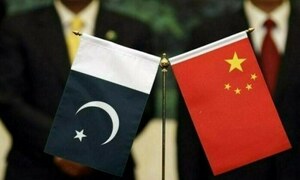The SECP may be adamant in requiring companies to post their financial statements on their websites but some firms just do not listen. One such firm is Gulistan Textile Mills Limited. Not only they have failed to update their FY14 financial statements on their website but even their FY13 statements are not available. So much for financial disclosures!
ABOUT GULISTAN TEXTILES The Gulistan Group was founded in 1966 and went on to become one of the largest vertically integrated textile groups in Pakistan. Gulistan Textile Mills has one of the largest spinning divisions in the country, with 9 industrial units spread throughout the country. Its production exceeds 70,000 tons a year (a number that might be grossly outdated), and covers a wide range of yarn varieties.
PRIOR PERFORMANCE The company has consistently been making losses since FY12 and in its latest half yearly accounts, its auditors warn of its ability to continue as a going concern. This means that the near-fifty year story of Gulistan Textiles could be close to an end. "Due to net losses, net current liabilities position and uncertainty related to outcome of law suits filed against the company indicate existence of material uncertainty about its ability to continue as a going concern," its auditors said according to the company's notice to the Karachi Stock Exchange.
The auditors added that "due to pending litigations in the court mark-up interest has not been accrued and balance confirmation letters from financial institutions have not been received". The exact details behind these affairs are not easily available, since as we mentioned earlier, the firm's detailed annual accounts for the last two years are not available on its website, if it can be called as such.
As can be seen from the graph, the company' sales declined in FY12 and the bottom line stood at a loss of nearly Rs 10 billion. From there onwards, the firm's bottom line losses managed to recover; but only because its top line continued its almost-linear downward journey.
In FY14, sales plummeted by 41 percent year-on-year, leading to a gross loss of Rs 650 million - pretty bad but still Rs 100 million less than the prior year's loss. Other operating expenses skyrocketed from Rs 4 million in FY13 to Rs 224 million by the end of June 2014. But Gulistan's saviour came in the form of other income; other income grew by 852 percent to Rs 800 million and offset most of the damage, covering a bulk of the losses/expenses and providing a much-needed cushion to the bottom line. The company's bottom line improved by 84 percent to a loss of Rs 175 million - this sentence says a lot about Gulistan's FY13 and how making losses has become a norm for it.
1HFY14 PERFORMANCE In its most recent financial results for the six month ended December 2014, Gulistan's top line fell by 85 percent year-over-year. Accordingly, its gross loss for the period stood at Rs 247 million as against gross loss of Rs 351 million in 1HFY14.
Intuitively, one look at the numbers gives a feeling that Gulistan Textile Mills has literally stopped trying; selling & distributive expenses, other operating expenses, other income, and finance cost all but ceased to exist. The top line comparison with the prior year also shows the extent to which the company's operations have been muted.
All this gave a bottom line loss of Rs 175 million - an 84 percent improvement over the comparable period's humongous loss of Rs 1.1 billion. There seems to be no signs of turning a profit, so it seems the company has decided to minimise its losses.
In an increasingly competitive environment, Gulistan's costs were impacted by the extensive power outages in the country, not to mention inflationary pressures. Moreover, banks and financial institutions had unilaterally blocked the company's working capital, which meant that it didn't have enough capital at its disposal to operate at optimum capacity, resulting in inefficiency. The impact of this was seen on the company's sales turnover, export orders, and profitability. To top everything off, the company is currently in the midst of a lawsuit with United Bank Limited.
INDUSTRY OUTLOOK Pakistan's textile industry contributes 8 percent to national GDP and has maintained an average 54 percent share of national exports. But there is massive potential that needs to be tapped. The government's new textile policy (2014-2019) bodes well for the industry. The aim is to double textile exports from $13 billion to $26 billion over the next five years. In the process, this will result in the creation of 3 million new jobs.
Pakistan is the fourth-largest producer of cotton in the world, and third in terms of yarn production. Through the new policy, the government seeks to ensure that small and medium enterprises be integrated into the textile sector to increase the production of value-added items.
The tariffs that protect the textile industry also create inefficiencies. So, the Ministry of Textile Industry wants tariffs to be cascaded in order to benefit from fibres other than cotton such as nylon, polyester, and silk. The implementation of these policies is paramount, if Pakistan is to compete with India and Turkey in the international market, where their lower-priced goods are dominating. Then again, for a firm with uncertainty over going concern has little room to benefit from what can be termed a generally positive industry outlook.
==================================================================================
Gulistan Textile Mills Limited
==================================================================================
Rs (mn) 2QFY15 2QFY14 1HFY15 1HFY14
==================================================================================
Sales and processing receipts 81.5 521 165 1144
Cost of sales & processing 237 838 412 1485
Gross loss 155 316 247 351
Selling & distribution expenses 0.025 3.7 0.23 8.6
Admin & general expenses 8.6 25 18 50
Other operating expenses 3.6 43 3.8 79
Net other income 0.06 693 0.085 713
Operating loss 168 304 269 227
Finance cost 0.809 10 1.7 10.6
Share of loss/profit from associated companies 15
Loss after taxation 162 285 257 216
==================================================================================
Source: Company notice to KSE
=======================================================================




















Comments
Comments are closed.